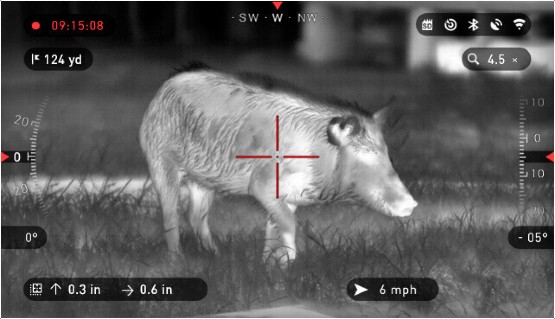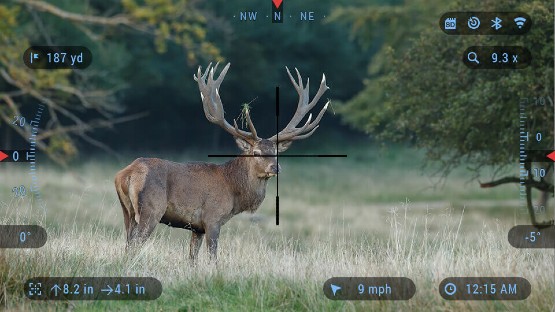With help from ATN who are experts in this field, we examine the difference between Night Vision and Thermal Scopes.

The night vision versus thermal scope debate is ongoing, with hardcore supporters for each technology. Yet, each has strengths depending on where and when you hunt, the conditions you encounter, the prey you seek, and your budget. This article distills the knowledge from ATN experts to assist you in making the optimal purchase decision.
Night Vision Scopes
The technology behind night vision scopes has hugely improved in recent years, with digital technology proving a game-changer for reduced cost, complexity, and improved capability. Yet, the concept behind night vision technology has not changed.
How they work
Night vision relies on intensifying the available visible and infrared light to enhance an image. Digitalization has enabled modern night vision technology that is smaller, lighter-weight, and cheaper than its predecessors.
It converts the image entering the objective lens to a digital signal using the same device that captures images in digital still and video cameras. Once the signal is digitized, a processor magnifies and enhances the image before displaying the result in black and white on a screen, which the hunter views through the scope's ocular lens.
Night vision Pros and Cons
Pros
Day or night use
Older night vision technology was unsuitable for daytime use. Today's digital night vision scopes are not so constrained and maybe used at any time, thanks to their CMOS technology and processing capabilities.
Target recognition
Target recognition is superior when using night vision scopes, as they enhance the available light to paint an accurate picture of the prey, enabling accurate identification before taking a shot.
Cost
Modern digital technology has steadily reduced in cost, given its widespread use. A professional day and night-vision scope costs less than half and up to a third of comparable thermal scopes.
Size and weight
Due to the technology employed, night vision scopes are generally lighter and smaller than an equivalent thermal scope.
Cons
Target location
Night vision scopes excel in fields and sparse forests or when the prey is moving. However, they can't see through foliage such as tall grass or dense treelines, and they won't see through smoke or fog. Unless the prey moves, you'll scan right past it in marginal light conditions.
Total darkness
Night vision relies on reflected light to enable enhancement. On moonless and heavily overcast nights, the clarity of the image suffers. An infrared illuminator is needed to supply sufficient light for reflection and enhancement to offset this drop in image quality.
ATN's best night vision scope for hunting
ATN offers day and night vision scopes ranging from an affordable entry-level model to high-end professional equipment. The following three models provide outstanding night vision performance.
ATN X-Sight LTV 5-15x
The X-Sight LTV is a day/night scope for those needing a scope that's light on both the rifle and your pocket. Weighing only 1.7 pounds or 780 grams, the size and weight of the LTV 5-15x make it an adaptable solution for platforms like crossbows or air rifles where weight is important. While lightweight and low-cost, the LTV 5-15x offers enhanced high-definition night vision and is constructed to the same exacting standards as our high-end professional scopes.
The extremely low power consumption of the X-Sight LTV gives over 10 hours of continuous use on one charge of its internal battery. Mounting to your rifle is easy using standard 30mm rings, the LTV 5-15x provides ATN's one-shot zero capability and 30 fps video recording at 720p quality.
ATN X-Sight 4K Pro 3-14x
Step up to our professional scopes, and you'll find the X-Sight 4K Pro 3-14X. The Pro 3-14X carries a higher specification sensor, offering ultra-high-definition image performance and outstanding night vision capabilities. ATN has packed the X-Sight 4K Pro range of scopes with the features needed by hardcore hunters. Built of hardened aluminum alloy with impact-resistant electronics, the Pro 3-14X is designed to deal with the heavy recoil pressures of high caliber weapons.
You can dual-stream 1080p video at 30, 60, and 120 fps, while the recoil-activated feature captures the shot even when you forget to activate the video. The ballistic calculator uses your weapons profile and the environmental conditions to ensure your shot hits the target every time. With a dynamic reticle and the option of a one-click connection of a laser rangefinder, the X-Sight 4K Pro 3-14X is a long-range hunter's dream.
ATN X-Sight 4K Pro 5-20x
The Pro 5-20x is one of our premium night/day scopes for long-range and open area hunting, with a 5-degree (240 ft) field of view. The ultra-high-definition optics of the scope provide an exceptionally crisp sight picture at any magnification, day or night.
Providing 18 hours of hunting on one charge, the X-Sight 4K Pro is wi-fi and Bluetooth-capable for control, streaming of video, and remote viewing. The scope also includes an infrared illuminator. As with the Pro 3-14X, the Pro 5-20x ships with a ballistic calculator, dynamic reticle, and the same video definition, fps, and recoil-activated features.
Thermal Scopes
Thermal imaging is rapidly becoming a mainstream technology used by the military and is gaining acceptance in commercial activities. It is increasingly useful for self-driving vehicles.
How they work
Thermal imaging uses an infrared sensor to measure each object's relative heat, or infrared emissions, within its field of view. The intensity of the infrared emissions dictates the heat intensity, with lighter colors hotter and darker colors cooler.
Thermal imaging indicates shape and location, as warm-blooded mammals are usually hotter than their surroundings. Hunters often use thermal rifle scopes when seeking deer or pigs in a crop or high-foliage environment, as their thermal signature will display even when hidden.
Thermal scope Pros and Cons
Pros
Good day or night operation
Without a moon and during heavy overcast, the thermal scope operates without degrading the image as it uses temperature rather than light.
Great in poor environmental conditions
Thermal scopes allow hunters to see game hidden behind tall grass, foliage, smoke, or dust. Where night vision fails, thermal scopes continue to provide heat signature indications.
Target location
Unless the game is behind hard cover or very dense foliage, the detection range of thermal scopes exceeds the capability of night vision scopes. They can detect game even when it’s still and hidden.
Tracks residual heat
The passage or presence of a warm-blooded object in a colder environment will leave behind heat residue until the temperature cools. A thermal scope can identify that residual heat to enable tracking.
Cons
Target recognition
The image provided by a thermal scope makes it difficult to recognize the target once located, unlike when using night vision scopes. While the hunter will quickly locate the heat signature, it isn't always easy to identify the target sufficiently well to take a shot. Is that a calf you've spotted or a small deer?
Size and weight
While the technology continuously improves, thermal scopes are generally 15 to 20% heavier and bulkier than their comparable night vision alternative.
Cost
As a newer technology, thermal scopes cost more than night vision scopes. Thermal scopes will cost two to three times that of a comparable night vision scope.
Local hunting regulations
Hunting regulations differ between countries and from state to state in the US. Scotland does not allow thermal scopes for hunting at any time, while California imposes special laws for using infrared imaging when hunting pigs. Hunters should check the laws of their hunting area before making expensive purchases.
ATN's best thermal scopes for hunting
ATN MARS 4 384 2-8X
The MARS 4 384 2-8X is a great introduction to thermal scopes. It uses the latest thermal sensor with a high-definition resolution providing a detection range of 960 meters, with recognition to 480 meters, and identification at 300 meters. Offering the same features of the night/day vision scopes, the MARS 4 384 2-8X allows 18-plus hours of operation on a single charge. It weighs 2.03 pounds or 920 grams.
ATN MARS 4 640 1-10X
The MARS 4 640 1-10X weighs 1 pound less than the MARS 4 384 2-8X and uses the same sensor. The battery life of the 640 1-10X is over 16 hours, and video recording and live streaming are available, as with most premium ATN scopes. The detection, recognition, and identification ranges are 830, 350, and 225 meters, respectively.
ATN MARS 4 640 4-40X
The MARS 4 640 4-40X offers the greatest magnification of our thermal scopes while providing the same features as the MARS 4 640 1-10X. The detection, recognition, and identification ranges of the 640 4-40X are the greatest of all our thermal scopes, at 3,300, 1,450, and 800, respectively. The MARS 4 640 4-40X weighs 2.35 pounds or 1.06 kilos.
Conclusion
The pros and cons of each scope show that there is no one answer to the perennial argument on which is better, night vision or thermal. Each has particular strengths, and only your hunting location, conditions, game, and wallet size will identify the scope most suitable for your application.
County Deer Stalking would like to extend its thanks to ATN for this useful insight. We hope this comparison has helped you decide which is the right scope for you.





















